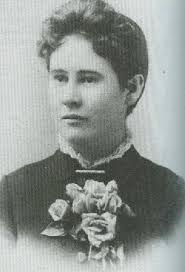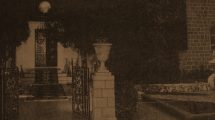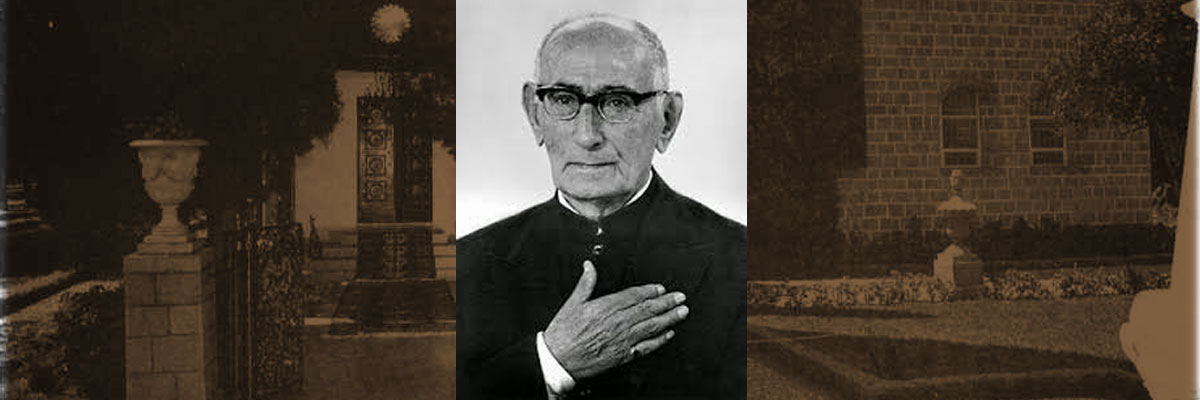 Ella M. Bailey
Ella M. Bailey
Born: December 18, 1864
Death: August 26, 1953
Place of Birth: Houston, Texas
Location of Death: Tripoli, Tarabulus, Libya
Burial Location: Delaware Veterans Memorial Cemetery, Millsboro, Delaware
On being informed of the death of Miss Ella Bailey, pioneer who accompanied Mr. and Mrs. Robert Gulick in their settlement of Tripoli, Libya, the Guardian on August 30 cabled:
“Grieve passing valiant exemplary pioneer. Reward (in) Kingdom bountiful.” ‘Oh, Ella Bailey, Ella Bailey! Oh, Ella Bailey, Ella Bailey! Oh, Ella Bailey!’. . . He kept repeating my name as He looked off into space. But He put into my name every possible emotion. That was the wonder of it.” These words of ‘‘Abdu’l-Bahá, spoken in Chicago in 1912, conveyed to Miss Bailey this meaning:
“My child, you are going to suffer. You are going to have a great deal of sorrow, and you are going to have a great deal of pain. Life is going to be hard.”
Miss Bailey remarked in an interview forty years later, “In those few words, He gave me all the emotions of a lifetime. He gave suffering but with it He gave me faith and strength. This made me feel His spiritual power and His truth.” While she was an infant, the family moved to San Diego County, California, and settled on a ranch. She was stricken with infantile paralysis at the age of two and one of her limbs remained paralyzed. As a child, she developed a fondness for the outdoors and learned, despite her physical handicap, to ride horseback expertly.
Her desire to serve mankind became apparent in her youth. She chose to enter the teaching profession not because of the rather meager financial reward attached to it but by reason of the manifold opportunities it afforded for child guidance. After graduating from normal school in southern California, Miss Bailey moved to Berkeley and began her career as a teacher. She taught various elementary grades and was deeply loved by her pupils who continued to remember her as the decades passed.
When she retired in 1924 because of ill health, the principal of McKinley School wrote her a note of gratitude and appreciation for her services and her example. “I cannot close this letter,” he wrote, “without telling you again what a precious thing your friendship has been to me and will continue to be, and how we all have been inspired by your courage and faith.”
Photographs taken in her youth attest to her beauty and winsomeness. She deliberately decided to forego the pleasures and rewards of marriage in order to give greater service to a larger number of people than a family group comprises.
The immortal Lua Getsinger instructed Miss Bailey in the Bahá’í teachings. Miss Bailey was one of the “waiting servants” who embraced the Faith prior to the American visit of ‘‘Abdu’l-Bahá.. As the friends in California did not expect the bounty of a visit to the Pacific Coast, several of them journeyed to Chicago to be sure of meeting Him. Miss Bailey made the trip with her intimate friends, Mrs. Ella Cooper and her mother, Mrs. Helen Goodall. A year or two before her passing, she recalled her meeting with ‘Abdu’l-Bahá and how copiously she wept with joy despite her firm resolve not to do so. She said, (as recorded by Charles Cornell of Berkeley, California): “We wondered what He looked like, the color of His eyes, of His hair. After I had once seen Him, I never had words with which to express these things. They seemed so unimportant. . . . He greeted me by saying that He was happy to see me with my spiritual mother, thereby confirming a beautiful spiritual relationship that continued for life between Mrs. Goodall and myself.” It also sealed the relationship of sister between Miss Bailey and Mrs. Cooper.
The wonderful qualities of Ella Bailey were well known to her acquaintances and to the Bahá’ís in the San Francisco region. She was the first chairman of the Berkeley Bahá’í Assembly and was elected annually to that body for more than twenty years.
She was constantly teaching by word and even more, by deed, but she preferred always to remain in the background. In over twenty years of association with her, the writer does not remember having once seen her on a public platform. Far from seeking publicity, she avoided it. During her long residence at the Berkeley Women’s City Club, she used her membership to sponsor many Bahá’í gatherings. Her room became a kind of clinic for the distressed and disconsolate.
Hundreds have partaken of her spiritual and material hospitality and generosity. Her presentation of the message of Bahá’u’lláh was indeed like that of a royal subject giving his most precious possession to his sovereign. Gentleness and sweetness were her abiding traits. She never tried to force her opinions on anyone but ever beckoned the thirsty to come to the fountain and drink the water of life that will bring healing to men and nations. Her saintly life provided the best means of promoting the prestige of the Faith she so ardently espoused. Sound in judgment, she never aroused hostility nor did she compromise on principle. Many were her secret sacrifices. She would give sumptuous dinners for friends who were oblivious to the fact that their hostess very often contented herself with tea, toast, and perhaps a little soup. Her whole day passed in cheering the broken hearted, in helping the needy, in visiting the sick, and in refreshing the spirits of the unending stream of guests that came to see her.
On learning that Shoghi Effendi had expressed the hope that Mr. and Mrs. Gulick would pioneer in Africa, Miss Bailey secretly aspired to go with them. She was too humble to voice her desire but beamed gratefully when she was told that they would enjoy having her with them. Then a cloud came over her countenance and she replied, “It would be selfish of me to go to Africa and be a burden.” The Gulicks felt that her presence would be a blessing but to make sure of doing the right thing, cabled the beloved Guardian. The answer of Shoghi Effendi, “Approve Bailey accompany you,” constituted Ella Bailey’s marching orders.
The next question was whether both the African journey and the trip to Chicago for the Jubilee commemoration should be attempted. The prayerful decision was that it would be a pity for Ella Bailey to forego the opportunity of witnessing the dedication of the Temple which had gloriously risen on the spot she had seen as bare soil in 1912. She attended the main events of the Jubilee including the Temple dedication, viewed the portraits of Bahá’u’lláh and of the Báb, and, through the writer, signified at the Intercontinental Teaching Conference her determination to go forth as an African pioneer. She returned to Berkeley in excellent spirits and relatively good health. An old friend remarked that her voice had not been so light and gay in forty years. A few days later, sad to relate, she came down with pneumonia, spent some time in a hospital, and was obliged to leave her residence at the Berkeley Women’s City Club and live in a nursing home. Gradually she regained some of her health and strength and it was decided to start the journey. Old friends of older faiths were horrified at her decision to pull up stakes in California and settle on the old Barbary Coast of North Africa and they warned her that such a move would shorten her life. She smilingly answered, “I do not find it such a great sacrifice to give up living in a rest home.”
She left her adopted California on July 14, 1953, never to return. The next evening she stayed in the New York apartment of Dr. Fazly Melany where she was visited by two Hands of the Cause, Zhikru’llah Khadem and Musa Banani. Early the next morning she sustained a fall but there were no fractures and travel was resumed as scheduled. The next stopover was Rome where Professor Mario Fiorentini rendered all possible assistance. Miss Bailey had the misfortune to fall again with the consequence that the stay in Italy was cut short. Equipped with an oxygen mask, Miss Bailey was an excellent traveler. She arrived at Tripoli on July 20 and was met at the airport by two Bahá’ís.
During the closing days of her earthly existence, she was sometimes not conscious of her condition which worsened as a result of additional falls. Then again she would become painfully aware of her infirmities and would apologize for the work her sickness entailed. She knew that she was in loving hands and, when possessed of her faculties, repeatedly thanked Mrs. Shawkat-‘Ali Faraju’llah for the infinite pains she took in caring for her day and night. The presence in the room of two-year-old Robert Gulick III, always brought a smile to her face as she loved him deeply and had great faith in his future. Death came toward twilight, at eight o’clock on August 26, 1953. A half hour earlier she was visited by a former member of the Egyptian National Spiritual Assembly and by a young man of Persian ancestry who soon afterward became the first Bahá’í pioneer to the Fezzan. Friends quickly gathered at the bedside of the departed believer and they recited and chanted appropriate prayers in Arabic and English. It was a touching demonstration of international
Bahá’í solidarity, of uncalculated affection in an age of calculated risks. Particularly memorable was the moving scene in which an Egyptian friend kissed her fore-head and tearfully bade her farewell, “Goodbye, Miss Bailey.”
Interment was set for August 27 and on that day a second service was held at the Government Cemetery on the western outskirts of Tripoli. Friends were also present that evening when the casket was placed in a niche in the cemetery wall. In the Mother Temple of the West, a few days later, members of the American National Spiritual Assembly prayed for the progress of her soul in the realms on high.
 The very stones of the cemeteries testify to the preponderating share of the American Bahá’í women in the pioneering effort. They speak of incomparable Martha Root in mid-Pacific, of indomitable May Maxwell in the Argentine, of heroic Keith Ransom-Kehler near the King of the Martyrs and the Beloved of the Martyrs in Isfahan, of the immortal Lua Getsinger beside the greatest Bahá’í scholar in Cairo, and now of valiant Ella Bailey overlooking and blessing the shores of Tripoli. Her humility prevented her from writing to the Guardian but he perceived the inner worth and true greatness of this wonderful lady. No friend or relative understood her station as did Shoghi Effendi, and to us in Tripoli this was an added, though unneeded, proof that he is guided by God.
The very stones of the cemeteries testify to the preponderating share of the American Bahá’í women in the pioneering effort. They speak of incomparable Martha Root in mid-Pacific, of indomitable May Maxwell in the Argentine, of heroic Keith Ransom-Kehler near the King of the Martyrs and the Beloved of the Martyrs in Isfahan, of the immortal Lua Getsinger beside the greatest Bahá’í scholar in Cairo, and now of valiant Ella Bailey overlooking and blessing the shores of Tripoli. Her humility prevented her from writing to the Guardian but he perceived the inner worth and true greatness of this wonderful lady. No friend or relative understood her station as did Shoghi Effendi, and to us in Tripoli this was an added, though unneeded, proof that he is guided by God.
The Guardian requested three friends of American nationality in Tripoli to submit a design for a memorial marker on Miss Bailey’s grave which will one day, God willing, be in a Bahá’í cemetery. He wishes personally to bear the expense of this memorial. He has ranked her with the greatest of the noble band of Bahá’í teachers including those mentioned above and two who have more recently ascended to the Abha Kingdom: Marion Jack, whose persevering effort will ever merit emulation; and Dorothy Baker, whose extraordinary gifts as a teacher are matchless and whose radiant spirit continues to inspire all who knew her.
In leaving her home land and in sacrificing her life for the Cause of God, Ella Bailey qualified for the crown of martyrdom. In his cablegram at the conclusion of the Holy Year to the Intercontinental Teaching Conference at New Delhi, Shoghi Effendi paid tribute to Ella Bailey and acclaimed her contribution to the world crusade:
“Irresistibly unfolding Crusade sanctified death heroic eighty-eight-year-old Ella Bailey elevating her rank martyrs Faith shedding further luster American Bahá’í Community consecrating soil fast awakening African Continent.”
Source:
The Bahá’í World. Kidlington, Oxford: George Ronald Publisher. Volume XII pp 685-688; -Written by Robert Gulick, Jr. -Permission given by George Ronald, Publishers
Images:
Courtesy of Maysan and Corey and Douglas Marshall-Steele






SHOCK AND AWE.
BAHA’I BROTHERS.
Though Baha’i men & women share equal rights, the latter, on a level playing field, in several ways–are superior beings in Abdul Baha’s estimation.
http://bahaiteachings.org/equality-superiority-of-women
MAMMA MIA
Maybe it’s because this mere male’s four doting sisters continue to indulge this sinner, as the plenitude of our decrepitude beckons, that I feel the need to point out an important omission vis-a-vis the role played by several American female pioneers unnamed in this otherwise splendid article:
It was Hand of the Cause of God, Agnes Alexander of Hawaii, and to a lesser degree her compatriot Ida Finch, who were instrumental in promulgating the Faith among the Japanese, even to the founders of Oomoto, a branch of Shintoism, as chronicled by Barbara Sims of the USA in her A1 work, ‘Japan will turn ablaze’.
https://bahai-library.com/compilation_japan_turn_ablaze
An incredible photograph taken in Iran during the Great War depicts American Baha’i women in action, more so than in words, teaching the Faith among Persian notables, including a prince of the realm whose name is not withheld. That they somehow effected in that benighted land interaction between the latter, with Baha’i and Jewish teachers, and with various classes in society and then recorded it on celluloid for posterity is little short of miraculous, Baha’i scholars should note imo:
Courtesy of the University of Georgia, USA, see page 66 re Agnes Alexander; page 97 shows American Baha’i women leading the way in Persia:
http://bahai.uga.edu/Realigas_la_Mondan_Pacon.pdf